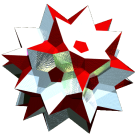bitrigonally diminished icosahedron,
vertex figure of bidex
©
⭳
- related Johnson solids:
- peppy teddi
- uniform relative:
- ike
- related CRF:
- bidex
- general polytopal classes:
- subsymmetrical diminishings
links

| Acronym | bitdi |
| Name |
chiral Weimholt hexahedron, bitrigonally diminished icosahedron, vertex figure of bidex |
| |
| VRML |
|
| Circumradius | sqrt[(5+sqrt(5))/8] = 0.951057 |
| Vertex figures | ovo&#(v,x)t, of&#x |
| Dual | selfdual |
| Dihedral angles | |
| Face vector | 6, 10, 6 |
| Confer |
|
|
External links |

|
A. Weimholt derived this selfdual hexahedron as the vertex figure of bidex in 2004, and reused it as the cells of tridex in 2005.
There is a vertex 4-coloring of ike. Diminishing the vertices of a single color then derives teddi by chopping off 3 peppies. Diminishing the vertices of 2 such colors derives this selfdual hexahedron; peppies then already would intersect, this is where the f-edges originate from. Diminishing 3 colors will result in the dual of teddi, and at all 4 colors results in the dual of ike, i.e. in doe.
Its faces are 4 (x,f,f)-triangles (i.e. ox&#f) and 2 (x,x,x,f)-trapezia (or xf&#x). It is a self-dual chiral polyhedron, in fact the dual is nothing but a rotated copy, i.e. dualization here even respects the handedness!
2 * * | 1 1 1 1 0 0 | 2 1 1 verf = ovo&#(v,x)t * 2 * | 0 1 1 0 1 0 | 1 1 1 verf = of&#x * * 2 | 0 0 0 1 1 1 | 0 1 2 verf = of&#x ------+-------------+------ 2 0 0 | 1 * * * * * | 2 0 0 f-edge 1 1 0 | * 2 * * * * | 1 1 0 f-edges 1 1 0 | * * 2 * * * | 1 0 1 x-edges 1 0 1 | * * * 2 * * | 0 1 1 f-edges 0 1 1 | * * * * 2 * | 0 1 1 x-edges 0 0 2 | * * * * * 1 | 0 0 2 x-edge ------+-------------+------ 2 1 0 | 1 1 1 0 0 0 | 2 * * ox&#f 1 1 1 | 0 1 0 1 1 0 | * 2 * ox&#f 1 1 2 | 0 0 1 1 1 1 | * * 2 xf&#x
© 2004-2025 | top of page |